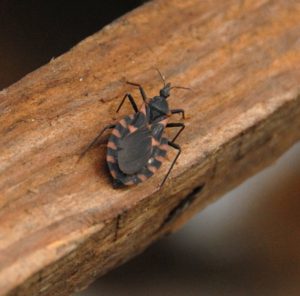
By Les Harrison
Wakulla County Extension Director
Contemporary Hollywood has glorified some of the horrific aspects to organized crime. The cinematic tales generally balance the personality facets of these dubious characters so there is some sympathetic sides to the individual who is committing the criminal acts.
The celluloid “hit man” is good example. Usually he, and occasionally she, spend approximately 90 minutes knocking off equally despicable players.
Rarely is there a cold blooded psychopath without any feelings for their acts willful mayhem. The insect world of Wakulla County, however, has just such a killer.
This native insect, Triatoma sanguisuga, is a member of the Triatoma family, a genus of assassin bug. This insect is commonly called a kissing bug because it targets the soft tissues around the mouth of mammals as one of its feeding sites.
As if being in the assassin bug family is not bad enough for its reputation, this pest’s South American cousin is responsible for inoculating victims with Chagas disease. Chagas disease, a protozoan, fortunately is rare in these latitudes.
The bloodsucking conenose found in Wakulla County is a brown, winged bug, 3/4 inch long, with the edges of its abdomen alternating in light and dark colors. They have a slender, straight beak with piercing-sucking mouthparts. The antennae are inserted on the side of the head between the eyes and the end of the beak.
They are rarely seen during the day, instead hiding in leaf litter and other debris near their intended host. Birds apparently consider them quite tasty and are easy targets for avian predators.
Kissing bugs primarily feeds at night on the blood of sleeping animals, such as raccoons and opossums which burrow in the vicinity.
The life cycle of the conenose can vary considerably depending on temperature, humidity, and availability of hosts. Females lay one egg at a time, up to five eggs each day.
A total of 200 to 300 eggs can be produced each year by one female. The females scatter the eggs in inconspicuous places out of the view of potential predators. The broad distribution gives the young kissing bugs a better chance of survival.
The eggs are very small, 1.5 mm long, white, and hatch in approximately 13 to 35 days. There are eight nymph stages before the conenose reaches maturity. The adults can live from six months to three years.
Problems arise when these insects encounter humans. If this creature enters a home or dwelling, its nocturnal habits make humans easy prey.
The bloodsucking conenose will enter into a home by crawling through cracks in the foundation, torn window screens, or other structural flaws or inadequacies. Many times they enter by simply clinging to a domestic pet or to the clothing of an unaware person.
Once indoors, they relocate to protected sites. These can include bedding, cracks in the floors and walls, or under furniture.
Most bites from conenose bugs are rarely felt. However, some can be quite painful and infection can occur if the bite wounds are scratched and contaminated.
If located indoors, it is up to the home owner to make them an offer they cannot refuse.
To learn more about the bloodsucking conenose or “the kissing bug”, contact your UF/IFAS Wakulla Extension Office at 850-926-3931 or https://blogs.ifas.ufl.edu/wakullaco/
 0
0
